#1 - REDUCE LOADS / DEMAND FIRST - Solar Geometry
“SOLAR GEOMETRY IS THE DETERMINING FACTOR OF HEAT GAIN, SHADING AND THE POTENTIAL OF DAYLIGHT PENETRATION...”
Temperature, precipitation, wind and sunshine have a direct effect on buildings. A deliberate choice of surroundings may permit us to take advantage of the elements that make the environment more favorable.
Climatic conditions are measured and recorded, the data collected over a period of time provides a statistical record which shows the mean, maximum, minimum and variation of temperature, hours of sunshine, wind, etc. Precipitation records provide an indication of the availability of water; temperature records provide a measure of space heating requirements; rainfall records provide a basis for estimating run-off rates for sizing drains and culverts; wind and snow records provide a basis for estimating winds and snow loads on building structures.
THE SUN:
The sun provides FREE solar radiation and heat for our environment. The earth travels in an elliptical path around the sun, with the sun at one focus of the ellipse so the earth is closest to the sun when at one end of the major axis in December and farthest when at the other in June. The mean distance is 1.496 x 108 km. The intensity of solar radiation which varies inversely as the square of the distance from the source varies by 3.5% about a mean value of 1353 W/m2 at the earth. This has only a small seasonal change with respect to the amount of solar radiation we receive.
The number of hours of sunlight we receive each day is a product of both the incline of the axis of the earth, at 23.5 degrees from the perpendicular, and it position relative to the sun on its yearly rotation. The winter solstice for the northern hemisphere occurs about December 22, as at that time the sun is directly overhead at noon in latitude 23.5 degrees South (the Tropic of Capricorn). The summer solstice occurs about June 22 when the sun is directly overhead at noon at latitude 23.5 degrees North (the Tropic of Cancer). Cognizence of the sun angles is imperative in designing for sun access and penetration into interior spaces. Faces of the building receive differing amounts and quality of light depending on their orientation, time of year and time of day. Building layouts should be programmed to take advantage of solar quality.
The angle at which the sun's rays hit the atmosphere above us (and hence the earth) effect the amount of solar radiation we receive. The length of the atmospheric path is increased when the sun's rays are oblique to the earth's surface. It varies throughout the year from +23.5 degrees at the summer solstice to 0 degrees at the equinoxes to -23.5 degrees at the winter solstice.
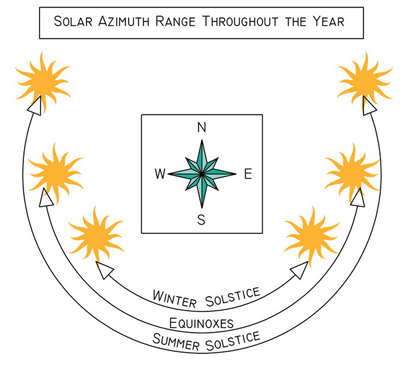
Solar Range in the Northern Hemisphere
The Atmosphere:
The atmosphere acts as a storage medium for thermal energy and as an agent in heat exchange at the earth's surface. It can also, by its circulation, transport heat from one region to another. Its greatest influence arises from its ability to intercept, absorb, and redirect incoming solar radiation.
The atmosphere consists of a mixture of gases held by gravitational attraction to the earth. It is compressed under its own weight, and varies in density with altitude and with temperature and water content. The composition by volume of dry air at ground level is 78% nitrogen, 21% oxygen, 0.8% argon, and 0.03% carbon dioxide. The atmosphere contains water vapour in amounts up to 4% by weight. The amount of water in the atmosphere varies with temperature, water existing as a gas, liquid or solid. Water has the ability to absorb solar radiation, hence it is cooler when there is cloud cover as the clouds intercept the heat from solar radiation.
Atmospheric circulation is caused by air currents. Heating of the ground by solar radiation creates rising warm air currents. Cooler air must flow in at ground level as a replacement and must itself be replaced as part of a pattern of circulation. Hence we have winds.
The density of the atmosphere decreases exponentially with altitude. The temperature decreases steadily from ground level to about 10 km up at a rate of 6o C per km, and above this remains fairly constant. The first layer of atmosphere is called the troposphere, the second the stratosphere, the boundary between them is called the tropopause.
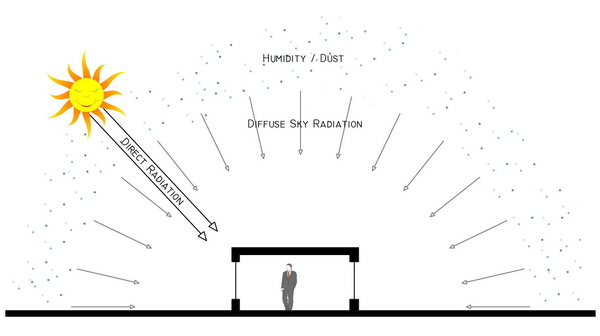
Types of Solar Radiation
KEY DEFINITIONS:
"Declination" refers to the tilt of the earth's axis measured from perpendicular to the sun's rays. This angle is 0 degrees at the spring and autumn equinox. Maximum declination is reached at the summer (23.45 deg.) and winter (-23.45 deg. ) solstice.
"Air Mass" is the effective thickness of the atmospheric path of sunlight relative to the shortest possible path. An air mass of 2.0, for example, is twice as long (thick) as the direct path. When the sun travels through higher air masses , less solar energy reaches the surface of the earth. This is a primary cause of seasonal weather. Beyond an air mass of 5.0, little sun will be received. Air Mass = 1 / sin(solar altitude angle)
"Solar Noon” occurs when the sun is at its mid point and highest angle of its daily path across the sky. The position of the sun relative to the horizon at this time is called "True South'. To determine the time of solar noon for your particular location, find out the time of sunrise and sunset. Solar noon is located at the midpoint between these times.
"Solar Time” is the measure of time which a sundial would read at any particular location. This is different from "clock' or "standard' time due mostly to conventions of time zones and Daylight Savings. Clock time error can be up to 2 hours from solar time. This might result in something up to a 30o error in predicting the sun's position. Magnetic deviation in the U.S. can be more than 20o east or west. Compounding these two errors makes the actual position of the sun unpredictable. If a structure is incorrectly oriented, its passive solar gain and shading strategies will be compromised and once built, very difficult to correct.
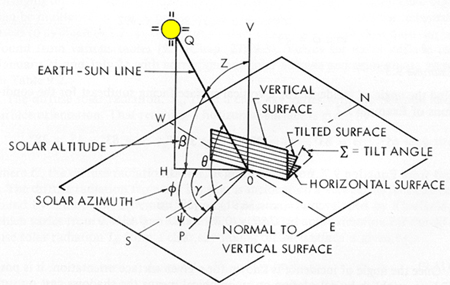
Visualization of the Varying Solar Angles
Two angles of general interest to architects are the AZIMUTH and ALTITUDE angles. These angles express the polar coordinates of the sun's position relative to a location on the earth's surface and provide general ideas about availability of solar energy and shading strategies at a particular time of year and day.
"Solar Azimuth” is the bearing of the sun from true south. At solar noon, the sun is at true south and the solar azimuth angle is defined as 0. Morning angles are measured as negative.
"Solar Altitude” is the bearing of the sun above the horizon. At sunrise and sunset, the solar altitude angle is 0. At solar noon, the sun reaches its highest point (greatest altitude). For locations within the tropics (between the Tropic of Cancer and the Tropic of Capricorn at 23.45 deg N. Latitude and 23.45 deg S. Latitude respectively) the sun will sometimes reach a 90 deg altitude angle. At that time, the air mass is 1.0. The altitude angle is a function of latitude and declination of the earth as well as hour of day. For solar noon we can generalize the solar altitude angle in respect to latitude and declination as follows:
Summer Solstice (around June 21) at solar noon:
Altitude = (90o - latitude) + 23.45o
Winter Solstice (around December 21) at solar noon:
Altitude = (90o - latitude) - 23.45o
Spring/Fall Equinox (around March 21 and September 21) at solar noon:
Altitude = (90o - latitude)
WINDOW ANGLES:
Usually, architects are concerned about solar position in relation to the position of a window or solar collector. Without a good idea of the geometry involved, it is not possible to reliably design a fixed shading device or optimize exposure.
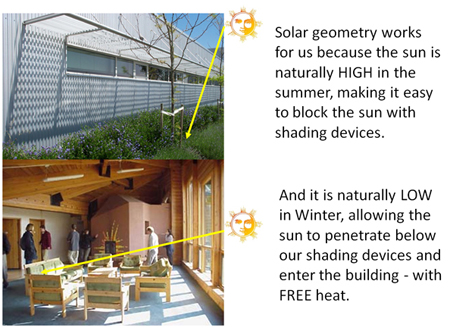
Benefits of Summer and Winter Sun Angles on a South Facing Elevation
"Window Azimuth" is much like the solar azimuth. But where solar azimuth is concerned with the bearing of the sun from true south, the window azimuth measures the bearing of the sun on the horizon from normal (perpendicular in plan) to the window. Before the sun's rays are normal to the window, the angle is expressed in negative degrees. Afterwards, the angles are positive.
"Profile Angle" is the vertical angle of the sun measured in section cut normal (perpendicular) to the window in question. When the window azimuth angle is 0, the profile angle is equal to the solar altitude angle; otherwise the profile angle is greater because it is visually foreshortened by the oblique viewing angle (turn a 45 deg triangle away from a flat elevation and it becomes progressively steeper until it reaches 90 degrees.
"Incidence Angle" is measured between the angle of the sun's direct rays and a line normal (perpendicular in all directions) to the surface of the window. At high angles of incidence, the path length of solar energy through glazing becomes very long and more energy is reflected and absorbed. Thus the angle of incidence has an effect on the shading coefficient and visible light transmittance of windows and skylights.
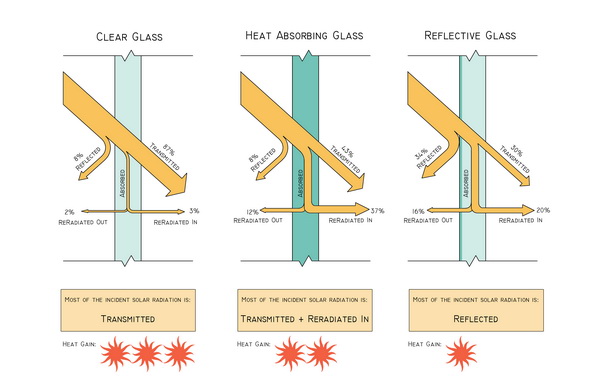
Incidence Angles and Glazing Types
The type of glass selected will greatly affect the penetration of solar energy into the interior space. For maximum solar heat gain, clear glazing should be selected. This type of glass can be manufactured to have a very low iron content to maximize solar penetration. Where solar heat gain is not desired, as in the case of interior load dominated buildings, other types of glazing should be specified that mimize heat transfer through the glass. Spectrally selective glazing has the ability to screen for certain wavelengths of light.
SOLAR RADIATION:
Solar radiation is important to consider in the design of buildings as it is possible to receive 'free energy' for heating the internal environment from the sun. Depending on the climate, it is also possible to avoid 'heat gain' if it is not desired.
The intensity of solar radiation outside the earth's atmosphere varies significantly with time of the year as the earth to sun distance changes. The effect of solar radiation on buildings is complex since the rate at which energy is delivered is highly variable with latitude, time of year, time of day, weather, surroundings, orientation of receiving surfaces and transmitting areas, and absorptance and emittance of receiving areas.
Sun Direction:
The sun's position in the sky can be expressed in terms of the solar altitude, b, above the horizontal and the solar azimuth, f, measured from the south. These angles are determined by the local latitude, L, the solar declination d, , and the apparent solar time (AST). The solar altitude at solar noon is given by:
bN = 90o - L + f
The solar altitude at other times of the day depends on the hour angle, H, which gives the rotation of the earth in the interval from noon to a particular time. Since the earth rotates 360 degrees in 24 hours, the hour angle changes 0.25 degrees for each minute.
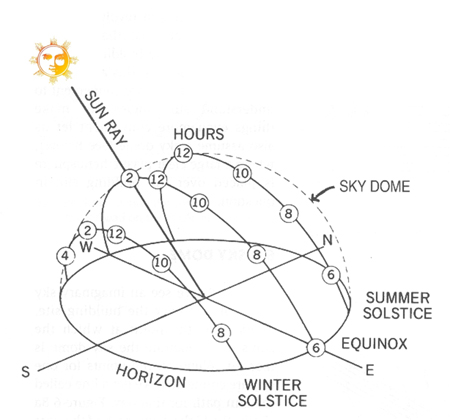
The Sky Dome Showing the Sun Angles for the Solstices and Equinox
This information is necessary in order to establish the angle of incidence of sunlight for a given surface orientation. It is possible to establish by calculation or by graphical means the shadows cast on surfaces so oriented by various projections such as window reveals, eaves, overhangs, and even adjacent constructions. Overhangs can be used to prevent the sun hitting glazing surfaces in the summer and prevent the gain of heat through solar radiation. If the overhangs are sized right, with the change in sun angle in the winter (it is lower in the sky) the sun's rays may be allowed to strike the glazed area permitting solar heat gain at the time of year it is most desired.
The intensity of the solar radiation varies with the atmospheric conditions. The sun considered to be at 1.2 times full intensity on clear days, 1.0 times on average cloudless days, and 0.8 times in industrial areas with pollution.
Solar Heat Gain:
Solar radiation of buildings may be incident on opaque surfaces such as roofs or transparent surfaces such as windows. When the receiving surfaces are opaque, the radiation is partially reflected; the remainder is absorbed, producing a rise in the surface temperature. Since the solar radiation is not constant, the temperature and the associated heat flow vary. The thermal storage characteristics as well as the heat transmission properties of the absorbing surfaces become involved in determining the rate at which heat will be delivered through the construction under the combined effects of the solar irradiation of the outer surfaces and the outdoor to indoor temperature difference. For example, when solar radiation hits dark coloured metal surfaces, the material is able to absorb heat very quickly. This heat is also lost quickly when the solar source disappears as the material has a low heat capacity. When solar radiation strikes concrete, the absorbtion rate is slow; however, the heat capacity of the material for thermal storage is high, so the heat remains in the material for reradiation long after the solar source is gone. In the case of windows the transmitted radiation is usually large, the thermal storage of the glass small and usually disregarded.
The Solar Heat Gain Factor (SHGF) is the total amount of solar radiation received by a window, measured in Watts per Meter squared (W/m2) in one day. These figures are found on Stephenson's Tables which list the number of watts received per for January 21 and July 21, by Latitude and by the direction the window faces (north, south, east or west).
When calculating solar heat gain through windows, it must be kept in mind that not all types of glazing transmit 100% of the solar energy available. Many products have been developed to reduce solar transmission. Tinted and reflective glazings reduce solar transmission to as low as 10% depending on the makeup of the coatings and ingredients. These type of products are typically used on commerical construction, not residential. In commercial construction, internal heat loads from people, lights and equipment make cooling a priority at all times of the year. The Shading Coefficient (SC) is a reduction factor whereby the type of glass reduces the amount of heat gain.
For the northern hemisphere, the maximum solar heat gain in the winter is achieved with south orientation. The minimum amount of heat gain in the winter is with north orientation, this orientation usually results in direct heat loss only. It is important to specify glazing with a lower U value for orientations where solar losses exceed gains.
During the summer the maximum heat gain is by east and west orientations as the sun angle is lowest in the morning and afternoon, allowing penetration into the building. These orientations are the most difficult to control as well through shading.
Because solar gain is different on all facades of a building it is important to design the windows, glazing selection and shading devices differently, in accordance with the sun angles and building exposure.
CALCULATING SUN ANGLES:
In order to properly design your building to acknowledge its solar geometry, it is critical to map out the sun angles for the project for key times of day and year. The minimum drawing set would include the winter and summer solstice, as well as the fall and spring equinoxes. All of the texts listed at the bottom of this page include sun diagrams for most latitudes, so are highly recommended. This website also provides an overview of some Sun Calculation Tools on our Survey of Tools page. Some of these devices are available free online.

Testing a Strategy for Shading on a Simple Heliodon
Massing models are also an extremely useful way of understanding the impact of the sun on the interior and exterior spaces of the building. If such studies are not carried out during the preliminary design stage, decisions regarding siting can be made that will negatively impact the solar potential of the building. A heliodon is a useful tool to test physical models. Follow this link to instructions for working with a heliodon for your project. A heliodon will not provide you with completely accurate data for early morning and late afternoon sun angles, but it will give you early feedback on the general effectiveness of your proposal, as well as photographic opportunities.
OVERSHADOWING:
It is critically important that the study of solar geometry not be limited to the building itself, but also include aspects of the site and surroundings. Shading studies should be done that account for adjacent buildings and high vegetatation.

HELPFUL LINKS IN THE AIA 50to50 WIKI:
Building Form
Building Orientation
Passive Solar Collection Opportunities
HIGHLY RECOMMENDED TEXTS FOR PASSIVE DESIGN (written by SBSE members!):
Heating, Cooling, Lighting: Sustainable Design Methods for Architects. Third Edition. Norbert Lechner.
Mechanical and Electrical Equipment for Buildings. Benjamin Stein, John Reynolds, Walter Grondzik, Alison Kwok.
Sun, Wind and Light: Architectural Design Strategies. Second Edition. G. Z. Brown and Mark DeKay.
The Green Studio Handbook: Environmental Strategies for Schematic Design. Walter Grondzik and Alison Kwok.
|

